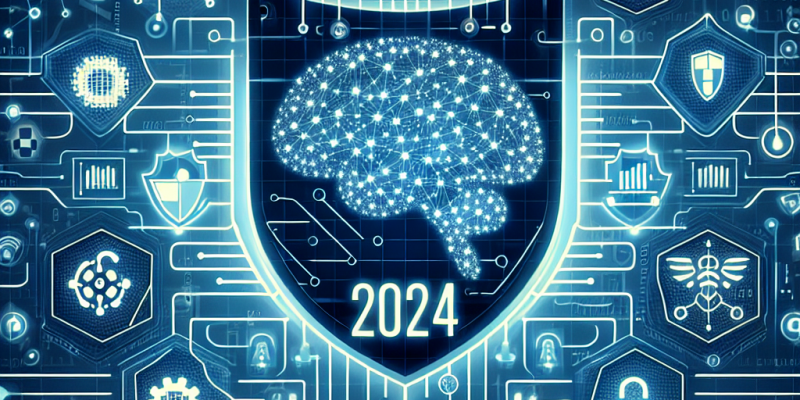AI and Cybersecurity: Harnessing Machine Learning to Combat Evolving Threats in 2024

AI and Cybersecurity: Harnessing Machine Learning to Combat Evolving Threats in 2024
As we delve deeper into 2024, the intersection of artificial intelligence (AI) and cybersecurity continues to evolve at an unprecedented pace. In a world where cyber threats are becoming increasingly sophisticated and pervasive, organizations are turning to machine learning (ML) as a pivotal weapon in their defense arsenals. This article examines the role of AI and machine learning in combating cybersecurity threats, the challenges that lie ahead, and the future landscape of secure digital environments.
The Evolving Threat Landscape
In recent years, cyber threats have morphed from conventional attacks into multifunctional, adaptive challenges. Ransomware attacks, data breaches, phishing schemes, and insider threats are just a few examples of the tactics employed by cybercriminals. In 2024, organizations face threats that are not only more frequent but also more complex, as attackers leverage advanced technologies such as AI to enhance their capabilities.
For instance, deepfake technology has rendered it increasingly difficult to distinguish between real and counterfeit digital content, leading to new forms of social engineering attacks. Moreover, the expansion of the Internet of Things (IoT) has created more entry points for cyber attackers, complicating the security landscape further. As a result, traditional cybersecurity measures are often inadequate to address these modern challenges swiftly and effectively.
The Role of AI and Machine Learning
In response to these evolving threats, organizations are harnessing the power of AI and machine learning to bolster their cybersecurity defenses. Here are some key ways these technologies are being utilized:
-
Threat Detection and Response: Machine learning algorithms can analyze vast amounts of data in real-time, identifying patterns and anomalies that signal potential threats. By processing information from various sources such as network traffic, user behavior, and system logs, AI can detect unusual activities indicative of a cyber attack, resulting in faster threat identification and mitigation.
-
Predictive Analytics: Predictive analytics powered by machine learning can forecast potential vulnerabilities and attack vectors before they are exploited. By assessing historical data and emerging patterns, organizations can preemptively strengthen their defenses and allocate resources more effectively.
-
Enhanced Authentication: AI technologies such as biometric recognition and behavioral analysis improve identity verification processes. By creating more secure authentication methods that adapt over time, organizations can significantly reduce the risk of unauthorized access and account takeovers.
-
Automated Threat Hunting: Automation driven by machine learning can elevate threat hunting capabilities. Security systems can autonomously scan for signs of a breach or impending attack, significantly reducing the response time and freeing up human analysts to focus on high-priority tasks.
- Phishing and Insider Threat Detection: AI systems can analyze communication patterns and flag potential phishing attempts or insider threats in real-time. Machine learning algorithms continuously refine their detection capabilities, adapting to new phishing techniques and tactics utilized by malicious actors.
Challenges in Implementation
Despite the significant advantages that AI and machine learning bring to cybersecurity, there are notable challenges in their deployment:
-
Data Privacy and Ethics: The integration of AI in cybersecurity raises concerns about user privacy and ethical data use. Organizations must ensure that they are compliant with regulations such as GDPR and CCPA while employing machine learning solutions.
-
Skill Gap: There remains a shortage of skilled professionals who can effectively implement and manage AI-driven cybersecurity strategies. Organizations must invest in training and development programs to cultivate a workforce proficient in both AI and cybersecurity.
-
Adversarial AI: As defenders employ AI, cybercriminals are also using AI to develop more sophisticated attacks, including evading detection by machine learning models. This ongoing arms race demands continuous advancements in AI methodologies to outpace attackers.
- Integration Complexity: Incorporating advanced AI systems into existing cybersecurity infrastructures can be complex and costly. Organizations must carefully consider their technology stack and create cohesive integrations between legacy systems and new AI-driven tools.
The Future of AI in Cybersecurity
Looking ahead, the role of AI and machine learning in cybersecurity will become increasingly central as threats continue to evolve. Predictive intelligence models will improve, allowing enterprises to anticipate and mitigate risks before they materialize. The collaboration between AI and cybersecurity professionals will also become vital, enabling teams to leverage machine insights while applying human judgment to nuanced situations.
Moreover, as federated learning and privacy-preserving techniques develop, organizations will find pathways to utilize machine learning while upholding data privacy. By sharing threat intelligence anonymously across sectors, businesses can create a more robust defense mechanism that benefits from collective insights without compromising individual data security.
In conclusion, as we navigate the cybersecurity landscape in 2024, leveraging AI and machine learning will prove indispensable against the backdrop of ever-evolving cyber threats. Organizations that embrace these technologies will not only enhance their security posture but also set the stage for a safer digital world for all. The fusion of human expertise and artificial intelligence holds the key to a resilient cybersecurity future, transforming how we protect our data and systems against adversaries.














